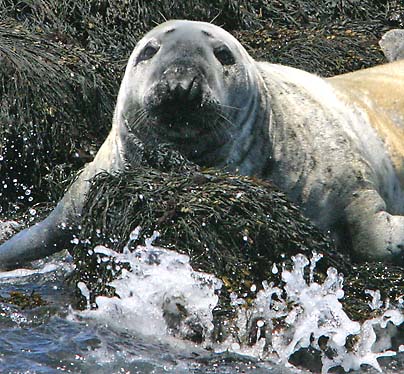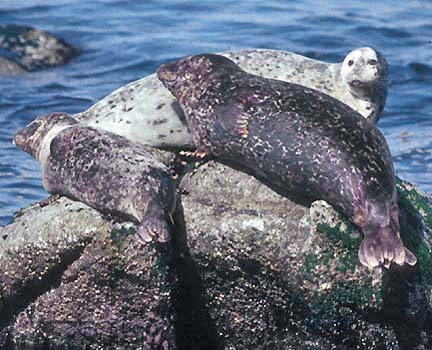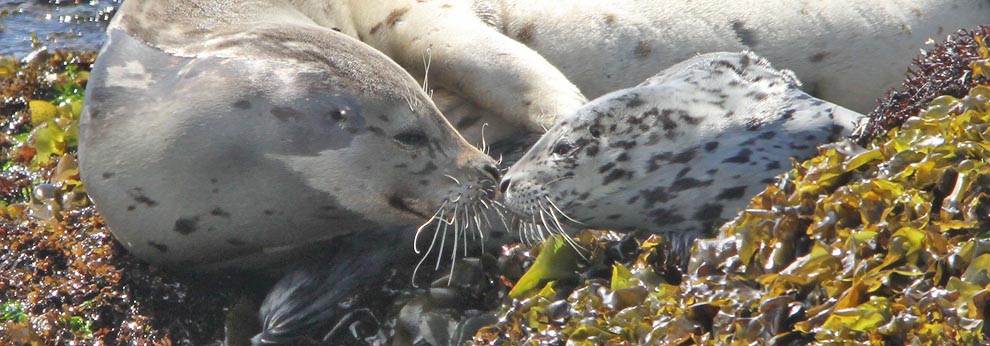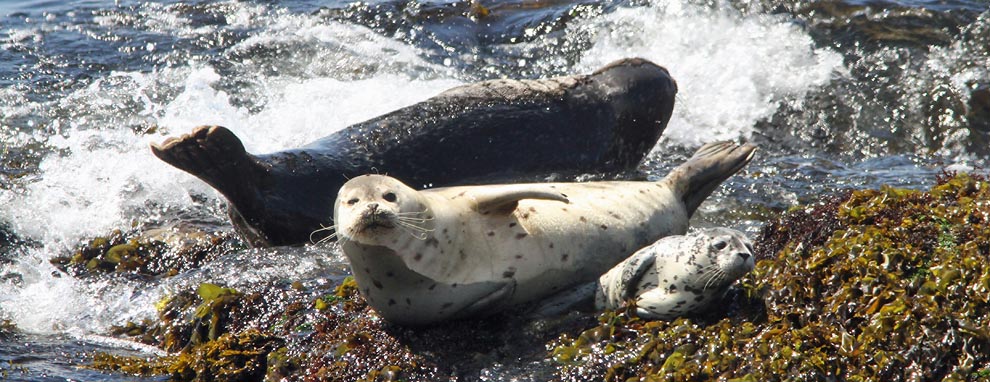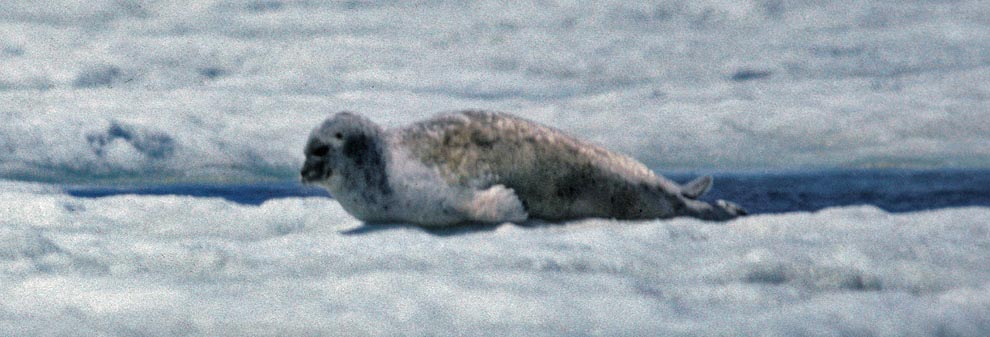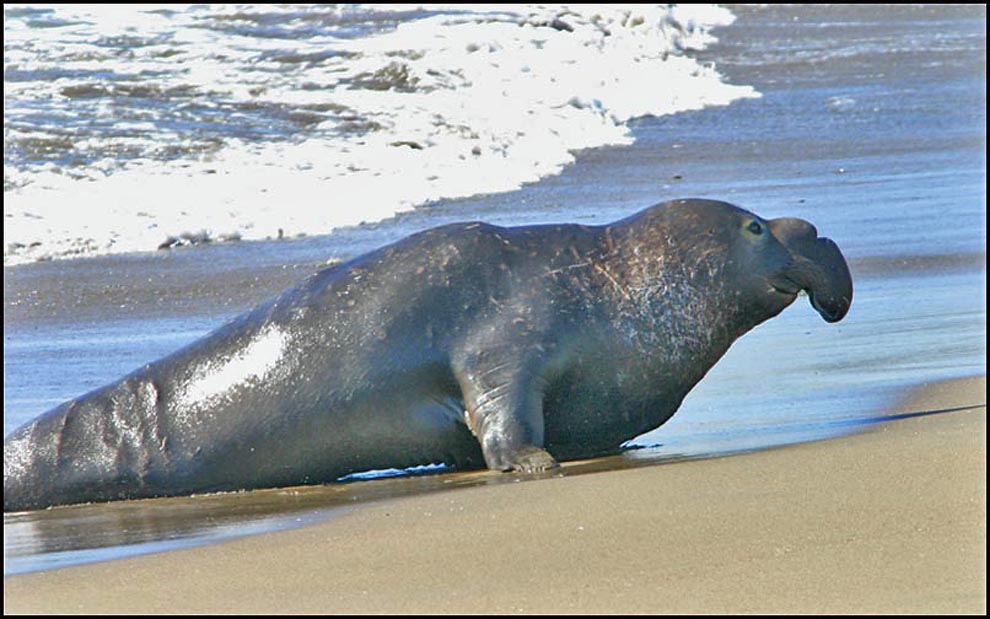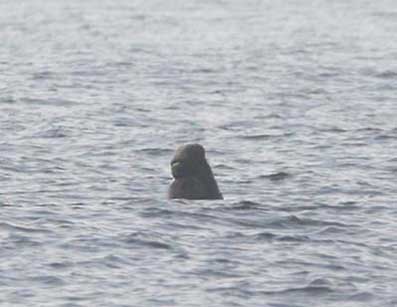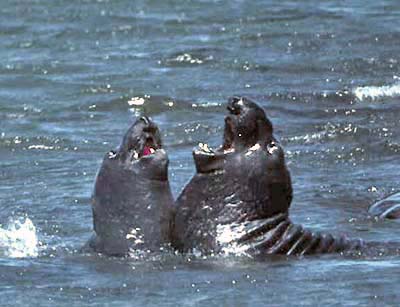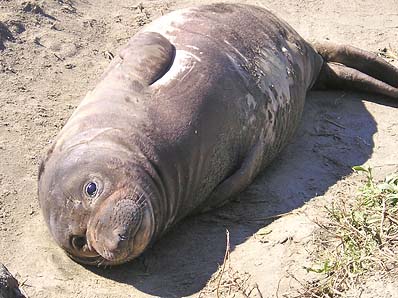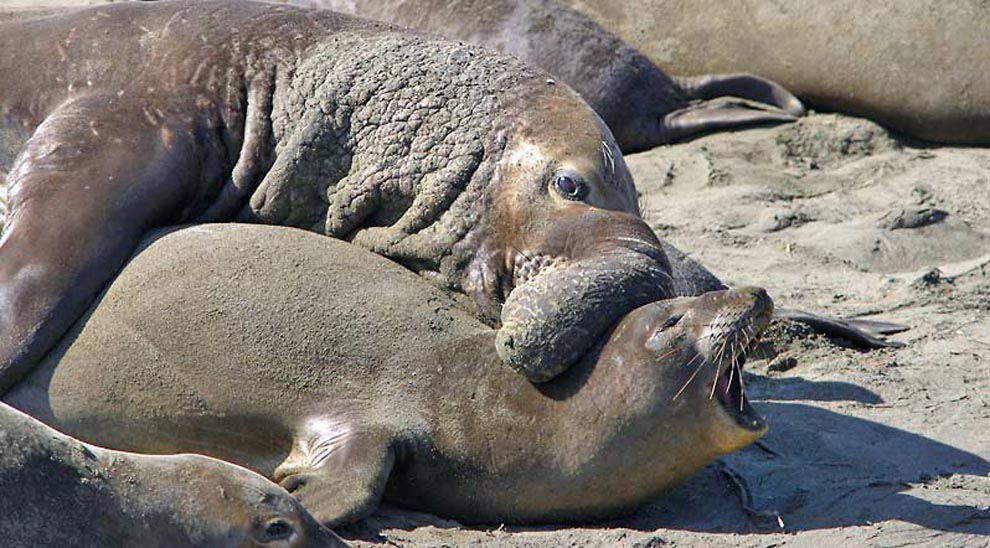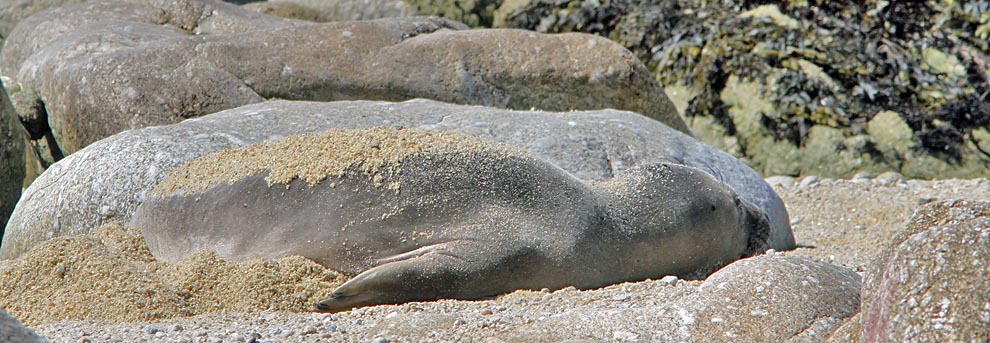FAMILY PHOCIDAE True Seals
|
Gray Seal 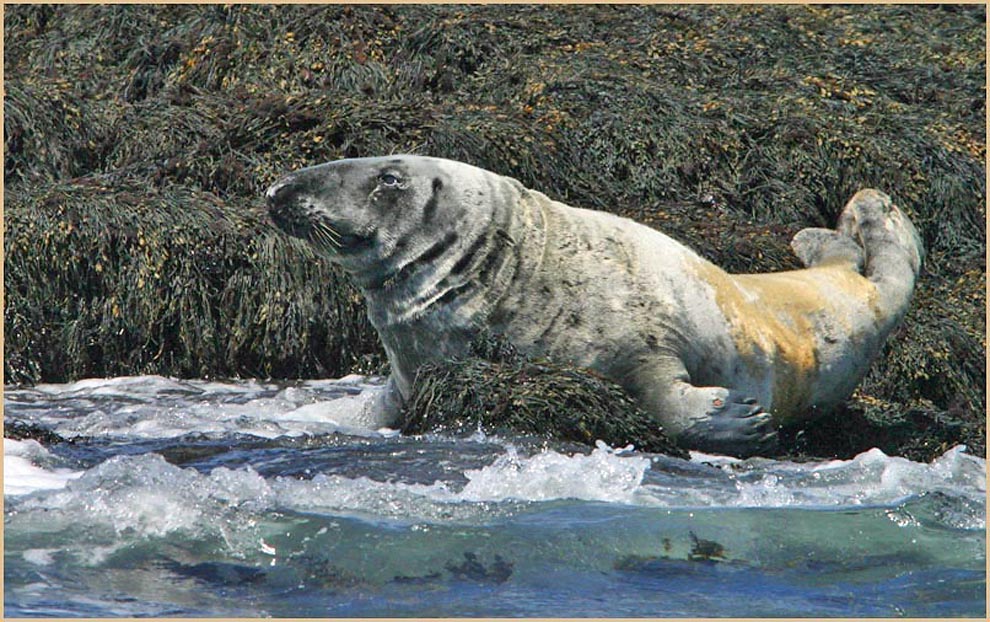
|
Gray Seal Halichoerus grypus
is a medium-sized, robust seal of the coastal north Atlantic. Males
have a long, downward-curved face; there is considerable variation in
pelage color. It is fairly solitary animal at sea, but both sexes
loosely aggregate on islands or pack ice (Shirihai & Jarrett 2006).
It eats mostly fish and cephalopods, but will take seabirds; it can
dive for up to 30 minutes and to over 300m depth. There are populations
on both sides of the north Atlantic.
My
only encounters have been at Machias Seal Island, a Canadian islet off
northern Maine, in summer. These photos are from there 19 June 2007.
The waters in the shots, splashing on the dense algae mats, look icy
cold to me and just say "North Atlantic." |
|
|
|
Harbor Seal
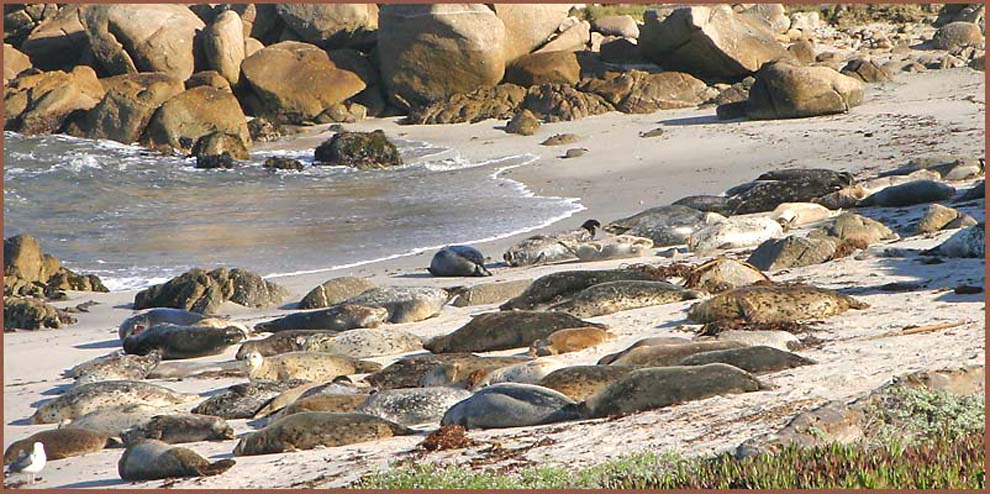 |
Harbor Seal Phoca vitulina
is the common, widespread seal along the coasts of the north Pacific
and north Atlantic. Where I live on the Monterey Peninsula, both Harbor
Seals and California Sea-Lions can be seen any day along the coast; the
seals lack external ears and have comparatively short puppy-dog-like
faces.
I am amazed by the variety of
colors and spotted patterns on these seals, ranging almost white to
black to rich orange-brown, depending on age, sex, and whether the seal
is wet or dry. They sun themselves on rocks and secluded beaches, but
forage among the kelp forests for fish, octopus, and squid. Pups are
born on a few local sandy beaches.
One of those beaches is near Cypress Pt., Pebble Beach, and the set of photos (below) show a mother with a pup.
These
photos from the Monterey Peninsula, California: Hopkins Marine Stations
(above, 20 Nov 2007), Pacific Grove (right, Feb 1995), and Cypress Pt.,
Pebble Beach (set below, 30 Mar 2013).
|
|
|
|
|
|
|
| |
|
Ringed Seal
|
| My only experience to date with Ringed Seal Pusa hispida
was with a few on ice flows in Hudson Bay during a boat ride from
Churchill, Manitoba (below, July 1988). This is a widespread Arctic
Ocean seal, and is the primary prey of Polar Bears during the breeding
season. They are among the smallest of the true seals and their
distribution is tied to landfast and pack ice. The small head, robust
body, and irregular light 'rings' on dark pelage are standard
characters. |
|
| |
|
Bearded Seal
|
| Likewise, my only encountered with Bearded Seal Erignathus barbatus
was a single individual on an ice flow in Hudson Bay during a boat trip
from Churchill, Manitoba (below, July 1988). The dense 'beard' of
whiskers is not apparent at this distance but it has a small broad head
on a large body, and is substantially larger than Ringed Seal. It is
also a circumpolar Arctic Ocean species with a distribution closely
associated with drifting sea ice. |
|
| |
|
Northern Elephant-Seal
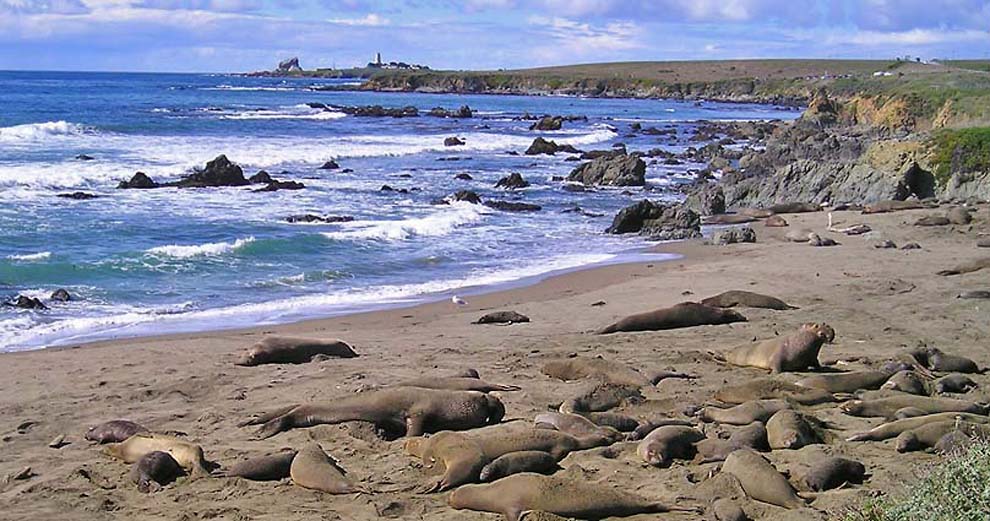
|
|
Northern Elephant Seal Mirounga angustirostris
is a very huge and impressive animal of the eastern north Pacific. When
away from the breeding beaches, they forage well out to sea (below). We
see them primarily on the few breeding beaches along the California
coast, where the beachmaster's roar (right) and fights between males in
the surf (below right) can be spectacular.
There
are only about 15 significant breeding colonies in the world, and two
of them are on California's central coast: Pt. Piedras Blancas, SLO,
and Año Nuevo Pt., S.M. Bulls arrive in December to set up
territories; dominate males may mate with up to 100 females.
When
not breeding, males move north to cold waters off Alaska while female
disperse out toward the center of the north Pacific. They feed mostly
on squid and deep-sea fish; they can dive for up to 2 hours and have
been recorded to 1567m deep (Shirihai & Jarrett 2006). These large
mammals can live for 25 years or more.
|
|
|
|
|
The
youngsters (left) on the breeding beaches are just adorable (left) but
sex between the huge male and small females is pretty rough (below). No
set of photos, though, can capture the sounds of beach — the grunts,
mews, and roars over a background of breaking surf and screaming gulls
. . .
All photos on
this page from Pt. Piedras Blancas on 19 Feb 2006, except that the surf
fighting bulls was from Año Nuevo in the 1980s, and the offshore
seal was in Monterey Bay on 27 Oct 2007.
|
|
|
| Northern
Elephant-Seals are not often encountered away from the breeding beaches
— except for an occasional seal offshore, and they tend to dive quickly
and are gone — but a few (likely young males?) have recently been
coming ashore on beaches on the Monterey Peninsula, including this one
(below) that quickly covered itself with lots of sand (30 Mar 2013 Pebble Beach). |
|
|
|
Literature cited:
Jefferson,
T.A., M.A. Webber, and R.L. Pitman. 2008. Marine Mammals of the World:
a Comprehensive Guide to their Identification. Academic Press, London.
Shirihai,
H., and B. Jarrett. 2006. Whales, Dolphins, and other Marine Mammals of
the World. Princeton Univ. Press, Princeton, N.J.
|
TOP
Page created 22 Nov 2007, revised 30 Mar 2013 |
|

